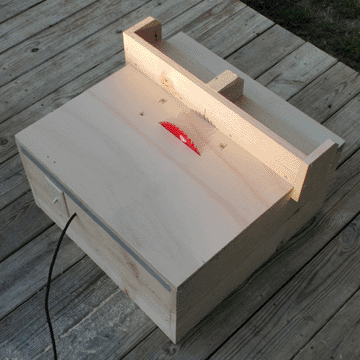

The table saw is a very versatile tool for working with wood. For previous projects I had to borrow one, so I decided to make one out of an old circular saw. It is 23 by 23 inches across, and is 12 inches tall. I made the table square so that the ripping fence can double as a crosscut sled when turned sideways. The top panel is friction-fit with wooden pegs underneath the plywood, so that in the future it can be exchanged with other panels that have different tools mounted; for example, a router or a jigsaw. The saw is also removable from the panel, so it can still be used as a circular saw. To reduce friction, the plywood was oriented so the grain was parallel with the saw blade. Strips of aluminum flashing were epoxied to the sides as bearings for the crosscut sled, and also as shims since the sled had a bit of play. In the ripping orientation, the fence is a tight friction fit and requires (for now) no additional clamping mechanism.
The saw cuts well, and has a maximum depth of cut of just over 1.5 inches, allowing me to work with 2x4s. In operation, the saw is fairly quiet due to the motor being enclosed in the box. The complete enclosure also traps the sawdust under the box, so it doesn't make a mess. Currently I intend to use the saw at floor level to save space and weight, but I left enough room to add legs in the future. The crosscut sled is a little tall, and I may eventually make a shorter one; it is somewhat difficult to reach over it while pushing it, to hold the workpiece down. I may also add a hook on the side to hold the rolled up power cord, and handles to make it easier to lift.
This project was fairly cheap compared to buying a table saw; the circular saw was free, a new blade cost $15, and the table cost about $50 to make.


I have since modified this saw by moving the blade forward 3.5 inches (it was previously centered). This allows for crosscuts of up to 6 inches, allowing me to work with 2x6 boards. I also added markings to the table surface for positioning the fence and as a depth guide for crosscuts.